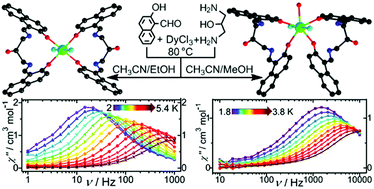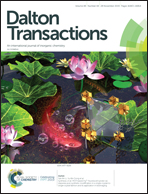Two mononuclear dysprosium(iii) complexes with their slow magnetic relaxation behaviors tuned by coordination geometry †
Abstract
Two mononuclear dysprosium(III) complexes [Dy(H3NAP)2Cl2]Cl·EtOH (1) and [Dy(H3NAP)2(H2O)Cl2]Cl·−2CH3CN·MeOH·0.5H2O (2) were obtained by coordinating an in situ formed Schiff base ligand of 1,3-bis(2-hydroxynaphthalenemethyleneamino)-propan-2-ol (H3NAP) to the dysprosium(III) ion. Their Dy(III) centers are six and seven-coordinated in octahedral and pentagonal–bipyramidal coordination geometries, respectively. Their structural difference is caused by the additional coordinated water molecule in the equatorial positions of complex 2 in comparison with that of complex 1. The well designed semi-rigid ligand contributes significantly to the low coordination numbers of Dy(III) ions in the two title complexes, as well as to their structural difference. Magnetic investigations revealed that complexes 1 and 2 are both field-induced single-ion magnets (SIMs) with their effective energy barriers being 22.9(6) and 153.9(5) K, respectively. They are typical SIM examples with their performances tuned by the coordination geometries of metal ions.



 Please wait while we load your content...
Please wait while we load your content...